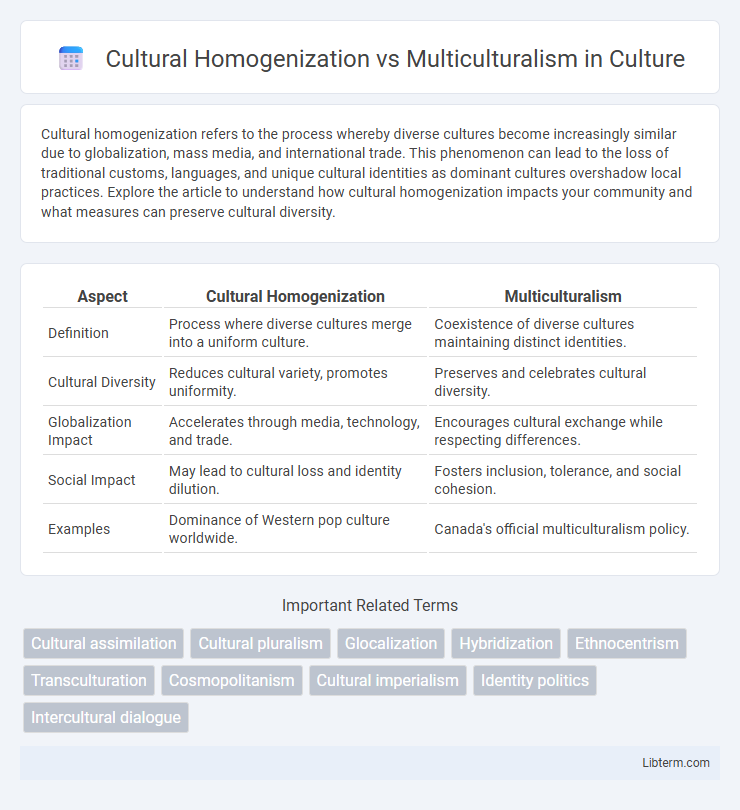Cultural homogenization refers to the process whereby diverse cultures become increasingly similar due to globalization, mass media, and international trade. This phenomenon can lead to the loss of traditional customs, languages, and unique cultural identities as dominant cultures overshadow local practices. Explore the article to understand how cultural homogenization impacts your community and what measures can preserve cultural diversity.
Table of Comparison
| Aspect | Cultural Homogenization | Multiculturalism |
|---|---|---|
| Definition | Process where diverse cultures merge into a uniform culture. | Coexistence of diverse cultures maintaining distinct identities. |
| Cultural Diversity | Reduces cultural variety, promotes uniformity. | Preserves and celebrates cultural diversity. |
| Globalization Impact | Accelerates through media, technology, and trade. | Encourages cultural exchange while respecting differences. |
| Social Impact | May lead to cultural loss and identity dilution. | Fosters inclusion, tolerance, and social cohesion. |
| Examples | Dominance of Western pop culture worldwide. | Canada's official multiculturalism policy. |
Introduction to Cultural Homogenization and Multiculturalism
Cultural homogenization refers to the process by which local cultures are transformed or absorbed by dominant outside cultures, often resulting in a loss of cultural diversity. Multiculturalism advocates for the coexistence of diverse cultures within a society, promoting the preservation and appreciation of different cultural identities. These contrasting concepts highlight the tension between global cultural integration and the protection of cultural plurality.
Defining Cultural Homogenization
Cultural homogenization refers to the process by which diverse cultural expressions and identities become increasingly similar or uniform due to globalization, mass media, and dominant cultural influences. This phenomenon often leads to the erosion of local traditions, languages, and customs, as global brands, entertainment, and values overshadow indigenous cultural practices. The tension between cultural homogenization and multiculturalism highlights the challenge of preserving cultural diversity while navigating interconnected global societies.
Multiculturalism: Meaning and Principles
Multiculturalism is a social and political philosophy that recognizes and values the coexistence of diverse cultural identities within a society, promoting equal respect and inclusion for all cultural groups. Its core principles include cultural pluralism, mutual respect, and the protection of minority rights, ensuring that different traditions, languages, and beliefs are preserved and celebrated. By fostering intercultural dialogue and understanding, multiculturalism aims to create a harmonious society where diversity is seen as a strength rather than a challenge.
Historical Evolution of Cultural Homogenization
Cultural homogenization traces back to the age of exploration and colonialism when empires imposed dominant languages, religions, and customs on indigenous populations, leading to the erosion of local cultures. The spread of mass media and globalization in the 20th and 21st centuries accelerated this trend, promoting a dominant global culture driven by Western consumerism and technology. Despite this, pockets of resistance and efforts to preserve multicultural identities have emerged as counterforces to uniform cultural assimilation.
Rise of Multicultural Societies
The rise of multicultural societies has fostered greater cultural diversity and inclusion across urban centers worldwide, enhancing social cohesion through shared values and mutual respect. Increasing migration and globalization have facilitated the blending of cultures while encouraging the preservation of distinct ethnic identities, counteracting cultural homogenization. Policies promoting multiculturalism emphasize equitable representation and intercultural dialogue, contributing to dynamic, resilient communities enriched by diverse traditions and perspectives.
Drivers of Cultural Homogenization in the Modern World
Globalization, technological advancements, and mass media act as primary drivers of cultural homogenization by spreading dominant cultural norms, values, and consumer habits worldwide. Economic globalization fosters multinational corporations that promote standardized products and lifestyles, reducing cultural diversity. Urbanization and migration further facilitate cultural blending, often leading to the erosion of local traditions and languages in favor of a more uniform global culture.
Benefits and Challenges of Multiculturalism
Multiculturalism promotes social cohesion and economic innovation by fostering diverse cultural perspectives and inclusive communities. It enhances cross-cultural understanding and creativity, leading to enriched educational experiences and global competence. Challenges include potential social fragmentation and difficulties in balancing cultural identity preservation with integration policies.
Impacts of Globalization on Cultural Diversity
Globalization accelerates cultural homogenization by spreading dominant cultures, leading to the erosion of indigenous languages, traditions, and social norms. This process often marginalizes minority cultures, reducing cultural diversity and promoting standardized consumer behaviors and media content worldwide. Conversely, multiculturalism encourages the preservation and appreciation of diverse cultural identities within global interconnectedness, fostering inclusive societies that celebrate cultural plurality and resist cultural assimilation.
Case Studies: Homogenization vs Multiculturalism in Practice
Case studies from countries like France and Canada exemplify cultural homogenization and multiculturalism, respectively, highlighting contrasting national approaches to diversity; France's emphasis on assimilation promotes a unified cultural identity, often limiting visible cultural distinctions, whereas Canada's multicultural policies support the coexistence of diverse cultural groups within a shared societal framework. Research shows that cultural homogenization can streamline social integration but may suppress minority identities, while multiculturalism fosters inclusivity and cultural preservation but poses challenges in balancing group rights with national cohesion. Empirical data from urban centers demonstrate the practical outcomes of these models, revealing impacts on social harmony, policy development, and minority representation in public life.
Future Prospects: Toward Inclusive Global Cultures
Future prospects for global cultures emphasize fostering multiculturalism to enhance inclusivity and respect for diverse identities, countering cultural homogenization driven by globalization. Embracing technological advancements and cross-cultural communication nurtures hybrid cultural expressions that celebrate local traditions while promoting global interconnectedness. Policies supporting education, equitable representation, and intercultural dialogue play critical roles in shaping an inclusive future where cultural diversity thrives alongside shared human values.
Cultural Homogenization Infographic

 libterm.com
libterm.com